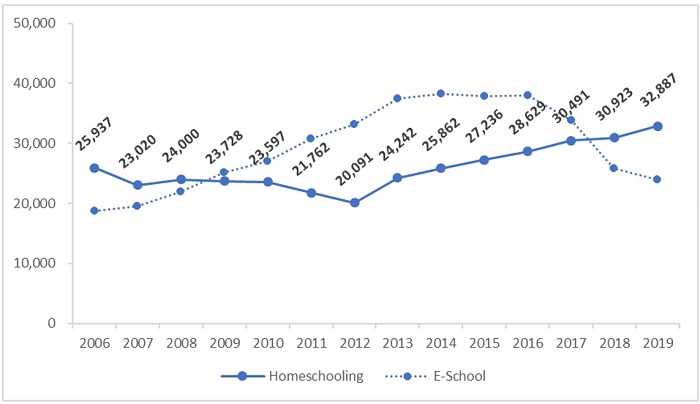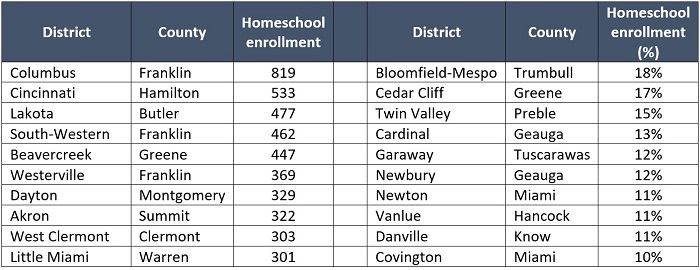With widespread school closings, the phrase “we’re all homeschoolers now” has entered our nation’s vocabulary. While many schools are doing their best to continue instruction through online or send-home material, the shutdowns also mean that millions of parents now have new responsibilities for their kids’ learning. (To help in this task, we at Fordham have compiled some of our favorite educational tips and resources, as have others.) With no clear end in sight to the health crisis—and closures during the 2020–21 school year possible as well—parents will likely continue to perform some type of “homeschooling” over the coming weeks and months.
A few commentators have suggested that this experiment in mass homeschooling will inspire more parents to continue this form of education once the crisis passes. Whether that materializes is yet to be seen, but the temporary need to stay home may be putting homeschooling on more parents’ radars. With that in mind, some families may be wondering how to continue at-home instruction, and this piece provides a short primer on Ohio’s homeschooling policies and trends. Note that this piece focuses on “traditional” homeschooling, not online learning via publicly funded virtual charter schools—another form of at-home education. E-school policies are much different and a discussion of them is a topic for another day (see here and here however for more).
Policy
Each state sets its own rules around homeschooling. Some states have tighter requirements, with Ohio being one of the more stringent states in two significant ways. First, Ohio parents must notify their local district that they’re homeschooling, something that several other states don’t require (e.g., Illinois and Michigan). In fact, the Buckeye State has fairly detailed notification rules. Prospective homeschooling parents must submit the following to their home district (among a few other minor items):
- Information about the parent or home teacher responsible for instruction.
- Assurances that at least 900 hours per year of instruction will be provided across a number of specific subjects.
- “Brief outline” of curriculum and list of textbooks and materials (these are provided for informational purposes only, and are not to be subject to evaluation by a superintendent).
- Assurances that the parent or home teacher holds at least a high school diploma, or equivalent.
The superintendent of a family’s home district reviews these notifications, and he or she may deny a parent’s request to homeschool based on non-compliance with the requirements above. While it’s not clear how often parents’ requests are denied (if ever), state rules detail an appeals process that includes an opportunity to provide more information to the superintendent, and eventually to make an appeal before a county juvenile judge.
The other major requirement that Ohio includes—which a number of other states do not—is testing. To continue homeschooling, parents must submit a yearly assessment report which may be based on: (1) a nationally normed referenced test; (2) a “written narrative” describing a child’s academic progress; or (3) an assessment that is mutually agreed upon by a parent and superintendent. But that’s not all. Should a homeschooling student fail to demonstrate “reasonable academic proficiency,”[1] the superintendent must intervene by requiring parents to submit quarterly reports about instruction and academic progress. If a child continues to fall short, the superintendent may revoke a parent’s right to homeschool their child, though that decision may be appealed to a county juvenile judge.
A few other homeschooling policies of note:
- No taxpayer funds support homeschooling parents.
- High school diplomas may be awarded by a child’s parents (students need not meet state graduation requirements).
- Homeschool students may participate in College Credit Plus.
- Homeschool students may participate in district sports and extracurricular activities.
- Students attending online charter schools are not considered homeschooled (see the note at the introduction to this piece).
From a compliance standpoint, homeschooling isn’t as easy as simply deciding to stop sending a child to school. Rather, Ohio parents face several procedural steps before they can homeschool. For better or worse, it’s not an entirely permissionless activity. But as the next section indicates, an increasing number of parents are wading through the red tape to homeschool their kids.
Participation
As the chart below indicates, roughly 32,000 students are homeschooled. While that represents a small fraction of all Ohio students (about 1.5 percent), homeschooling numbers have risen since 2012 even as Ohio’s overall school enrollment has declined. A number of factors could explain the uptick. Perhaps the post-recession economic growth has enabled more families to have a stay-at-home parent who can educate their kids. Maybe there’s some increased dissatisfaction with traditional school options (there’s some anecdotal evidence that African American parents are turning to homeschooling as an escape). It’s also possible that the 2013 adoption of a “Tim Tebow law” that permits homeschooled student to participate in district athletics has contributed. The recent declines in online charter enrollment (due largely to the closure of ECOT) might suggest that some former e-school parents are switching to homeschooling. Last, a growing network of supports (co-ops or support groups) and educational resources, including curricula and online materials, may be encouraging more parents take the plunge.
Figure 1: Number of homeschooled students, 2005–06 through 2018–19

Source: Ohio Department of Education. Note: Online charter school enrollments, another form of at-home learning, are also displayed for context.
Perhaps in support of the “network” hypothesis are data indicating that homeschooling is more popular in some places than others. The table below displays the top-ten districts with the most homeschooling students, in terms of both absolute numbers (left panel) and as a percentage of district enrollment (right panel). Not surprisingly, we see a mix of larg districts on the left side (mostly urban and suburban). But it’s interesting to note some differences in participation when comparing districts of similar size and demographics. For instance, the suburban Columbus district of Westerville has more homeschoolers (369 students) than the almost equally sized suburban district of Dublin (140 students). Similarly, Cincinnati has far more homeschoolers (533) than Cleveland (140 students). Are those differences due to stronger parent networks? Meanwhile, the right panel shows a number of districts with relatively high shares of homeschooling enrollment. Bloomfield-Mespo, north of Youngstown, leads the state with an 18 percent share and Cedar Cliff (near Dayton) is just behind. Again, it seems plausible to think that the availability of local supports explains the higher percentages of homeschooling.
Table 1: Top homeschooling districts in absolute numbers and as share of district enrollment, 2018–19

Source: For a full listing of homeschool enrollment by school district, see the ODE file “Homeschool Student Data.” Aside from enrollments, no other data on homeschooling students is available via ODE.
***
No school option, whether traditional district, public charter, private, or homeschooling, is the right fit for every family or student. Out of necessity, millions of Ohio parents are experiencing first-hand what homeschooling would be like. For many—likely the vast majority—they’ll come to a deeper appreciation of the hard work their local schools do to serve children. But some might just find themselves attracted to a form of schooling they would’ve never otherwise considered. For these parents, taking a look at the policies and the homeschooling supports in their community would be a good place to start.
[1] This term is only clearly defined in state policy when a norm-referenced test is used (scoring at least 25th percentile).


